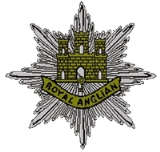
Royal Anglian Regiment
Overview
Infantry
Infantrymen are soldiers who are specifically trained for the role of fighting on foot to engage the enemy face to face and have historically borne the brunt of the casualties of combat in wars. As the oldest branch of combat arms, they are the backbone of armies...
regiment
Regiment
A regiment is a major tactical military unit, composed of variable numbers of batteries, squadrons or battalions, commanded by a colonel or lieutenant colonel...
of the British Army
British Army
The British Army is the land warfare branch of Her Majesty's Armed Forces in the United Kingdom. It came into being with the unification of the Kingdom of England and Scotland into the Kingdom of Great Britain in 1707. The new British Army incorporated Regiments that had already existed in England...
, part of the Queen's Division
Queen's Division
The Queen's Division is a British Army command, training and administrative apparatus designated for has the regiments from the east of England and the remaining regiment of Fusiliers. The Queen's Division was formed in 1968 with the regimentation of the Home Counties Brigade, Fusilier Brigade and...
.
The regiment was formed on 1 September 1964 as the first of the new large infantry regiments
Large regiment
A large regiment is a multi-battalion infantry formation of the British Army. First formed in the 1960s, large regiments are the result of the amalgamation of three or more existing single-battalion regiments, and perpetuate the traditions of each of the predecessor units.-Origins:Following the...
, through the amalgamation of the four regiments of the East Anglian Brigade
East Anglian Brigade
The East Anglian Brigade was an administrative formation of the British Army from 1948 to 1968. The Brigade administered the regular infantry regiments of eastern England....
.
- 1st (Norfolk and Suffolk) Battalion from the 1st Bn of the 1st East Anglian Regiment1st East Anglian RegimentThe 1st East Anglian Regiment was an infantry regiment of the British Army.As a result of defence cuts implemented in the late 1950s, the 1st Battalion, The Royal Norfolk Regiment and the 1st Battalion, The Suffolk Regiment amalgamated on 29 August 1959 to form the 1st Battalion, 1st East Anglian...
- 2nd (Duchess of Gloucester's Own Lincolnshire and Northamptonshire) Battalion - 1st Bn, 2nd East Anglian Regiment2nd East Anglian RegimentThe 2nd East Anglian Regiment was a short-lived infantry regiment of the British Army from 1960 to 1964. Its lineage is continued by the Royal Anglian Regiment....
- 3rd (16th/44th Foot) Battalion - 1st Bn, 3rd East Anglian Regiment3rd East Anglian RegimentThe 3rd East Anglian Regiment was an infantry regiment of the British Army. It was formed on 2 June 1958 by the amalgamation of the 1st Battalion, The Bedfordshire and Hertfordshire Regiment and the 1st Battalion, The Essex Regiment....
- 4th (Leicestershire) Battalion - 1st Bn, The Royal Leicestershire Regiment
The Royal Anglian Regiment serves as the county regiment for the following counties:
- BedfordshireBedfordshireBedfordshire is a ceremonial county of historic origin in England that forms part of the East of England region.It borders Cambridgeshire to the north-east, Northamptonshire to the north, Buckinghamshire to the west and Hertfordshire to the south-east....
- CambridgeshireCambridgeshireCambridgeshire is a county in England, bordering Lincolnshire to the north, Norfolk to the northeast, Suffolk to the east, Essex and Hertfordshire to the south, and Bedfordshire and Northamptonshire to the west...
- EssexEssexEssex is a ceremonial and non-metropolitan county in the East region of England, and one of the home counties. It is located to the northeast of Greater London. It borders with Cambridgeshire and Suffolk to the north, Hertfordshire to the west, Kent to the South and London to the south west...
- HertfordshireHertfordshireHertfordshire is a ceremonial and non-metropolitan county in the East region of England. The county town is Hertford.The county is one of the Home Counties and lies inland, bordered by Greater London , Buckinghamshire , Bedfordshire , Cambridgeshire and...
- LeicestershireLeicestershireLeicestershire is a landlocked county in the English Midlands. It takes its name from the heavily populated City of Leicester, traditionally its administrative centre, although the City of Leicester unitary authority is today administered separately from the rest of Leicestershire...
- LincolnshireLincolnshireLincolnshire is a county in the east of England. It borders Norfolk to the south east, Cambridgeshire to the south, Rutland to the south west, Leicestershire and Nottinghamshire to the west, South Yorkshire to the north west, and the East Riding of Yorkshire to the north. It also borders...
- NorfolkNorfolkNorfolk is a low-lying county in the East of England. It has borders with Lincolnshire to the west, Cambridgeshire to the west and southwest and Suffolk to the south. Its northern and eastern boundaries are the North Sea coast and to the north-west the county is bordered by The Wash. The county...
- NorthamptonshireNorthamptonshireNorthamptonshire is a landlocked county in the English East Midlands, with a population of 629,676 as at the 2001 census. It has boundaries with the ceremonial counties of Warwickshire to the west, Leicestershire and Rutland to the north, Cambridgeshire to the east, Bedfordshire to the south-east,...
- RutlandRutlandRutland is a landlocked county in central England, bounded on the west and north by Leicestershire, northeast by Lincolnshire and southeast by Peterborough and Northamptonshire....
- SuffolkSuffolkSuffolk is a non-metropolitan county of historic origin in East Anglia, England. It has borders with Norfolk to the north, Cambridgeshire to the west and Essex to the south. The North Sea lies to the east...
Initially formed of seven battalions (four regular and three Territorial Army), the regiment was reduced in 1975 with the loss of the 4th (Leicestershire) Battalion to three regular battalions and three TA.

